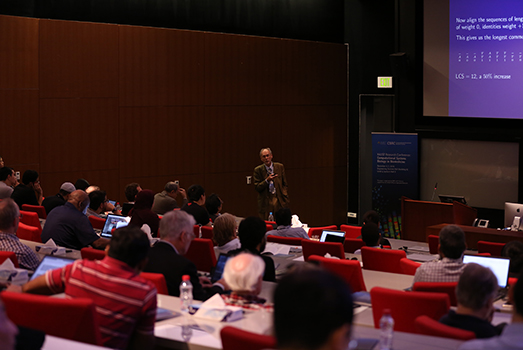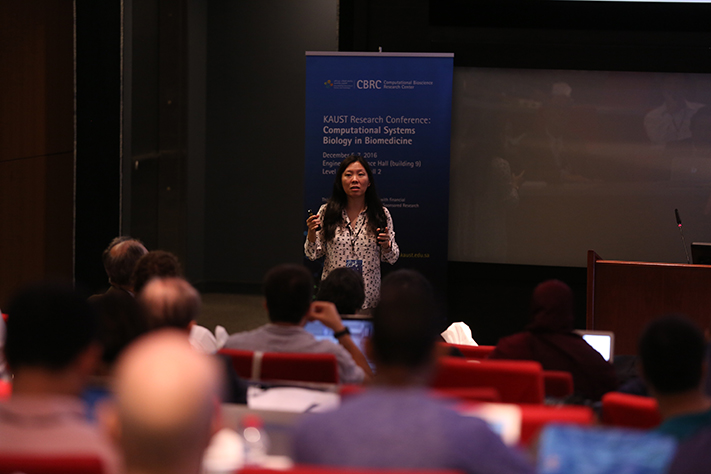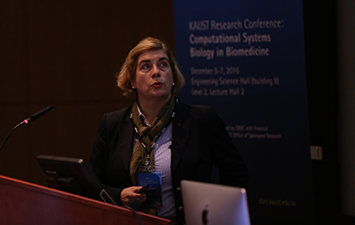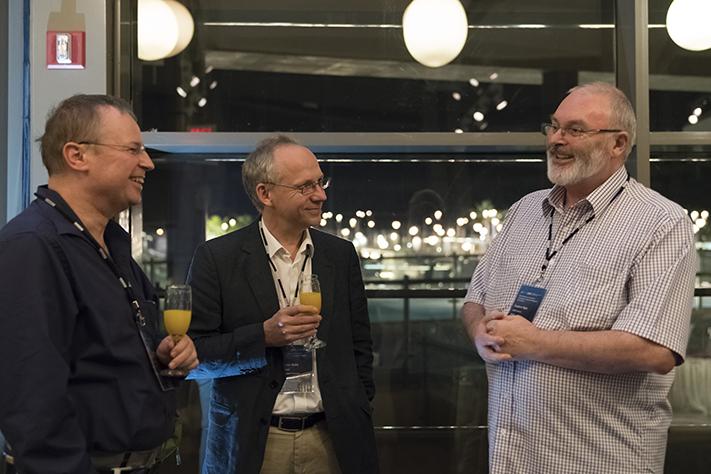Decoding biology’s future

Michael Waterman, professor of biological sciences, computer science and mathematics at the University of Southern California during his keynote address. Photo by Ginger Lisanti
The KAUST Computational Bioscience Research Center (CBRC) hosted the Computational Systems Biology in Biomedicine conference from December 5 to 7 on the University’s campus, providing the opportunity for some of the leading researchers in the field of systems biology to discuss and analyze the latest applications, developments and trends in biomedicine.
The conference, which was co-chaired by Vladimir Bajic, CBRC director, and Takashi Gojobori, CBRC associate director, welcomed an international group of invited speakers to KAUST from China, Germany, Japan, New Zealand, the U.K. and the U.S. The researchers supplemented an already strong in-Kingdom presence at the event.
Mootaz Elnozahy, dean of the University’s Computer, Electrical and Mathematical Science and Engineering division, noted, "The CBRC has been remarkable in the amount of change it has achieved in such a short time. Through these conferences, we want to stay connected the wider global scientific community."
 Wei Wang, director of the Scalable Analytics Institute, University of California, Los Angeles (UCLA), emphasized the need for clear-cut results and rapid results in her field of research during her presentation at the event.
Wei Wang, director of the Scalable Analytics Institute, University of California, Los Angeles (UCLA), emphasized the need for clear-cut results and rapid results in her field of research during her presentation at the event.
"In our line of work, we want to avoid ambiguous results. My team's philosophy is not to wait. We want to find a way to speed things up,” she said.
Imene Boudellioua, a Ph.D. student from the CBRC whose research is focused the application of machine learning and data mining algorithms for functional annotation of various biological entities, also discussed how data mining and algorithms can help unlock the secret of degenerative diseases.
"This is now truly the age of personalised medicine,” she said. “An individual will have 100 to 300 unique genome variations, and we must try and predict the deleterious effects of these variants. We want to extend our research to complex diseases.”
"Through our research, we can try and understand why causes organ failure. We have all the information at a molecular level, but we need to scale it up to a organ level and then on to a whole body level,” he said.
"Physiology and biology are the foundations of medicine. In the end, biology has to be described with mathematics. If you are importing a model, you have to know its relation in regards to other models. We achieve this through semantic indentations,” Hunter added.
Charlotte Hauser, KAUST professor of bioscience, spoke about amyloidosis and the factors driving self-assembly during her lecture on the second day of the conference. She noted self-assembly is necessary for developing small molecule therapeutic drugs that prevent amyloidosis.

“DNA is the code of life—it encodes information that makes proteins,” Hauser said. “Protein folding defines all life. We humans are the best example of self-assembly in nature,” she said.
Martin Noble, professor of structural biology and anticancer drug discovery at Newcastle University, spoke of the “data storm” facing structural biologists in drug discovery and electron microscopy.
“The need for new drugs is growing, but the rate of producing them is not growing. Computational bioscience and structural biology play a big role in drug discovery, and these can also anticipate other issues you face later down the drug development pipeline. They can help in finding small molecules that give you a toehold in drug discovery,” he said.
“Fragment-based drug discovery is a way forward, but is a data challenge, as it generates a lot of data. We need to pull together all the data from structural biology and other data to arrive at specific inhibitors that are useful as drugs,” he concluded.
“Our genome gives us the blueprint of our life, and influence from the environment gives us an imprint on our genome. About 300 human proteins take part in the reading and expression of these epigenetic codes,” he said.
Jysoo Lee, director of the KAUST Supercomputing Core Lab, highlighted that without the dedicated, resourceful and highly talented members of the University’s Supercomputing Lab, the type of research the symposium centered on would be increasingly difficult.
“I am proud of the expertise we have and the dedicated people in the Supercomputing Lab,” Lee said.
Continued collaboration
In his closing remarks, Bajic said, “Our research aligns with the research thrusts at KAUST, and our pride here at KAUST is that our academic standard is high."
He also thanked those who attended the conference, and especially those who travelled from abroad.
"Overseas guests, we really appreciate your attendance and your input over the past few days,” he said. “To all of you who made this symposium possible, we thank you, and we hope to have continued collaboration with you to continue to raise the profile of KAUST.”
The Computational Systems Biology in Biomedicine conference was organized by the CBRC with financial support from the KAUST Office of Sponsored Research.
The conference, which was co-chaired by Vladimir Bajic, CBRC director, and Takashi Gojobori, CBRC associate director, welcomed an international group of invited speakers to KAUST from China, Germany, Japan, New Zealand, the U.K. and the U.S. The researchers supplemented an already strong in-Kingdom presence at the event.
Mootaz Elnozahy, dean of the University’s Computer, Electrical and Mathematical Science and Engineering division, noted, "The CBRC has been remarkable in the amount of change it has achieved in such a short time. Through these conferences, we want to stay connected the wider global scientific community."
Computational systems biology
A considerable portion of work undertaken at the CBRC relates to computational systems biology (CBS), and throughout the collegial and thought-provoking event, attendees expanded on the conference’s main theme, discussing and debating CBS’s wider role. They also highlighted how biomedical research and applications can benefit a larger global community, not just the scientific community.
In a opening keynote lecture entitled “Statistical Issues of Sequence Comparison: Analysis by Position and Analysis by Pattern,” he highlighted how his work has contributed to some of the most widely used tools in the field, briefly covering statistical issues for global and local alignment, the Smith-Waterman algorithm (which he co-developed) and the Basic Local Alignment Search Tool (BLAST).
World-changing research
The role played of analysis by pattern or word counts has become increasingly important in biomedicine over the past few years. This subject was covered by Michael Waterman, one of the most prominent speakers at the event and professor of biological sciences, computer science and mathematics at the University of Southern California, whose research and findings in the field haven given him the title of “the father of computational biology.”In a opening keynote lecture entitled “Statistical Issues of Sequence Comparison: Analysis by Position and Analysis by Pattern,” he highlighted how his work has contributed to some of the most widely used tools in the field, briefly covering statistical issues for global and local alignment, the Smith-Waterman algorithm (which he co-developed) and the Basic Local Alignment Search Tool (BLAST).

Wei Wang, director of the Scalable Analytics Institute, University of California, Los Angeles (UCLA) during her keynote lecture. Photo by Ginger Lisanti
"In our line of work, we want to avoid ambiguous results. My team's philosophy is not to wait. We want to find a way to speed things up,” she said.
Imene Boudellioua, a Ph.D. student from the CBRC whose research is focused the application of machine learning and data mining algorithms for functional annotation of various biological entities, also discussed how data mining and algorithms can help unlock the secret of degenerative diseases.
"This is now truly the age of personalised medicine,” she said. “An individual will have 100 to 300 unique genome variations, and we must try and predict the deleterious effects of these variants. We want to extend our research to complex diseases.”
Physiology and biology—the foundations of medicine
In his keynote address at the event, Peter Hunter, director of the Auckland Bioengineering Institute at the University of Auckland, New Zealand, discussed multiscale systems biology and the physiome project."Through our research, we can try and understand why causes organ failure. We have all the information at a molecular level, but we need to scale it up to a organ level and then on to a whole body level,” he said.
"Physiology and biology are the foundations of medicine. In the end, biology has to be described with mathematics. If you are importing a model, you have to know its relation in regards to other models. We achieve this through semantic indentations,” Hunter added.
Charlotte Hauser, KAUST professor of bioscience, spoke about amyloidosis and the factors driving self-assembly during her lecture on the second day of the conference. She noted self-assembly is necessary for developing small molecule therapeutic drugs that prevent amyloidosis.

Charlotte Hauser, KAUST professor of bioscience gives her keynote lecture. Photo by Ginger Lisanti
“DNA is the code of life—it encodes information that makes proteins,” Hauser said. “Protein folding defines all life. We humans are the best example of self-assembly in nature,” she said.
Martin Noble, professor of structural biology and anticancer drug discovery at Newcastle University, spoke of the “data storm” facing structural biologists in drug discovery and electron microscopy.
“The need for new drugs is growing, but the rate of producing them is not growing. Computational bioscience and structural biology play a big role in drug discovery, and these can also anticipate other issues you face later down the drug development pipeline. They can help in finding small molecules that give you a toehold in drug discovery,” he said.
“Fragment-based drug discovery is a way forward, but is a data challenge, as it generates a lot of data. We need to pull together all the data from structural biology and other data to arrive at specific inhibitors that are useful as drugs,” he concluded.
Blueprint of life
Stefan Knapp, professor of pharmaceutical chemistry, Goethe University Frankfurt and the University of Oxford, discussed the rational design of selective inhibitors during the conference.“Our genome gives us the blueprint of our life, and influence from the environment gives us an imprint on our genome. About 300 human proteins take part in the reading and expression of these epigenetic codes,” he said.
Jysoo Lee, director of the KAUST Supercomputing Core Lab, highlighted that without the dedicated, resourceful and highly talented members of the University’s Supercomputing Lab, the type of research the symposium centered on would be increasingly difficult.
“I am proud of the expertise we have and the dedicated people in the Supercomputing Lab,” Lee said.
Continued collaboration

(L-R) Professor Peer Bork (EMBL) and Professor Martin Noble speak with Vladimir Bajic at the post-event function. Photo by Andrea Bachofen-Echt
In his closing remarks, Bajic said, “Our research aligns with the research thrusts at KAUST, and our pride here at KAUST is that our academic standard is high."
(L-R) Professor Peer Bork (EMBL) and Professor Martin Noble speak with Vladimir Bajic at the post-event function. Photo by Andrea Bachofen-Echt
He also thanked those who attended the conference, and especially those who travelled from abroad.
"Overseas guests, we really appreciate your attendance and your input over the past few days,” he said. “To all of you who made this symposium possible, we thank you, and we hope to have continued collaboration with you to continue to raise the profile of KAUST.”
The Computational Systems Biology in Biomedicine conference was organized by the CBRC with financial support from the KAUST Office of Sponsored Research.
Related stories
- The Computational Bioscience Research Center inauguration
- Center for Epigenetics and Metabolism and KAUST forge partnership to advance research in Epigenetics
- Charlotte Hauser elected NAI Fellow
- By David Murphy, KAUST News

